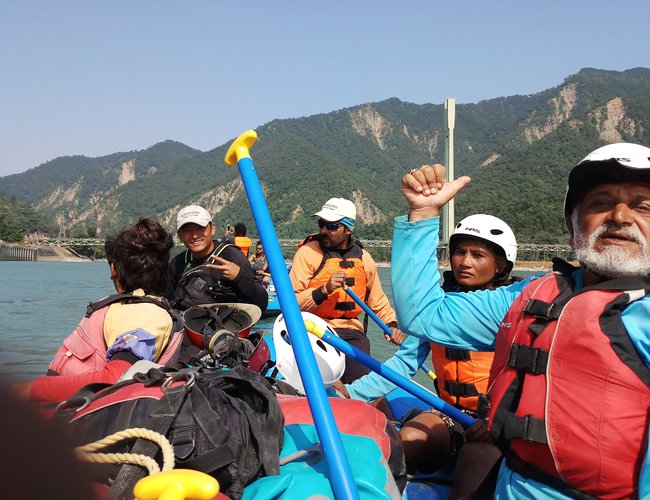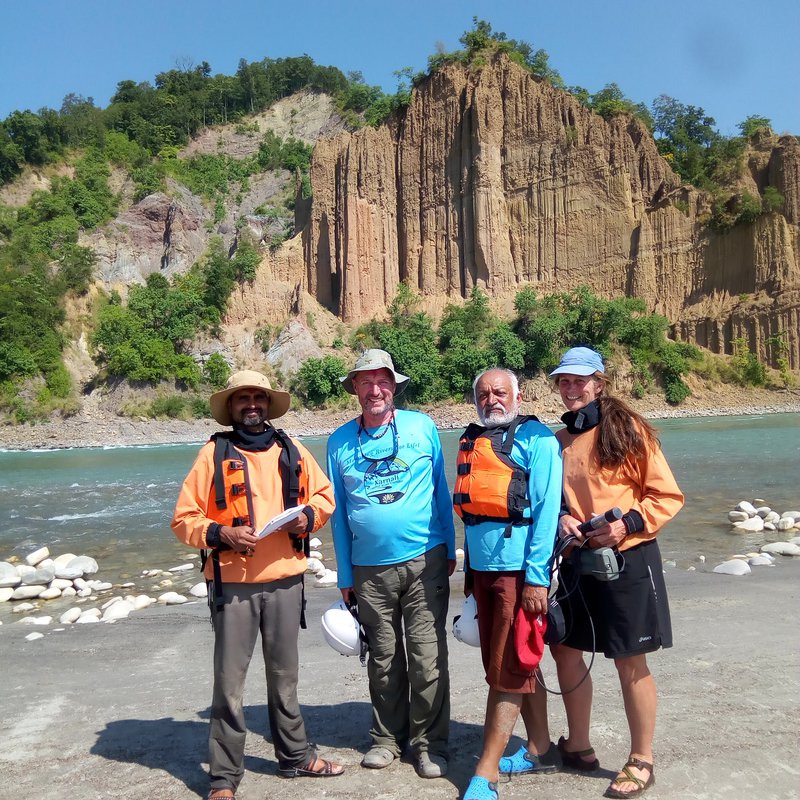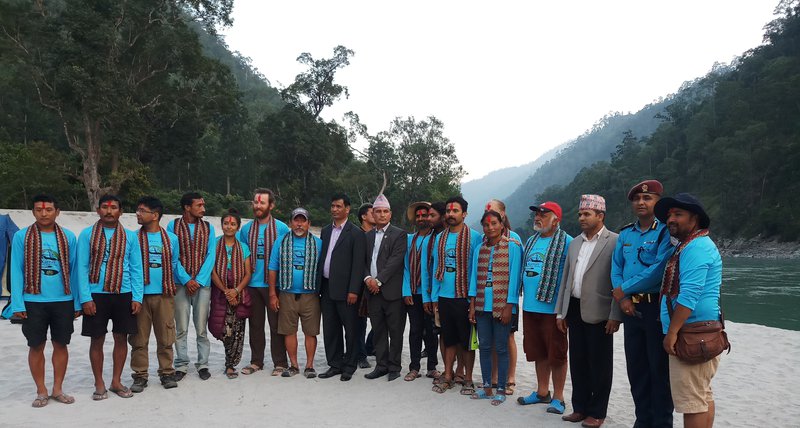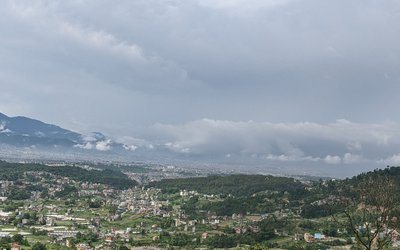
The Karnali River can be a boon for the development of aqua-tourism in Nepal. To its 10,050 km (Puramg district Tibet Chinato Gharghar Ganges India), mainstream and its major tributaries: Limikhola, Talungkhola (Salli), Kairankhola, Hepkakhola, Dojam river, Loti Mugu, MuguKarnali, Kawadikhola, Seti river, Tila and Bheri rivers well fed from the snow-capped Himalayas and trans-border landscape provide lot of scope and opportunities to the people of Karnali province and partly to SudurPaschim province and state 5 of Nepal. The mainstream (705 km) Hilsa-Humla to Sati/Geruwa (Kailali-Bardiya) corridor can come in better use for white water recreation, the most adventurous and incredible kayaking and rafting for about 10 days for kayaking and 8 days for rafting. The paddlers have to face several rapids on the way - Sweetness & Light, Jailhouse, Godhouse, Juicer and Flip and Strip with buzzing sounds - forward, stop, backwardpedal, right back - left back, hold on, get down, back over right + over left, etc. The whole Karnali river corridor can be divided into two sectors: Hilsa to Jitegadh (Tila-Humla-Karnali confluence) except near ChyatharaJharna where the Karnali goes under a rock, only for kayaking and all the way down Jitegadh to Seti/Geruwa for kayaking and rafting. This river corridor is full of scenic nature and vibrant ethno-graphic culture.
Karnali River is one of the major rivers of Nepal. Out of 6 thousand rivers only 16 rivers are feasible for water recreation business/rafting. It is till date undisturbed, free flowing, perennial, terrestrial and turbulent river of Himalayas.Except aqua tourism development and hydro power generation the Karnali River can come in least usage. For comprehensive utilization of the river, it can be divided into 3 sections: the upper part (Hilsa to Jitegadh) high hills is most potential for white water adventure tourism and hydropower generation, the middle hills section (Jitegadh to Chisapani) is for fishing and rafting, and the lowland or lower part (Chisapani to Sati/Geruwa) is for irrigation,e. For adventurous tourism, the Karnali River is full of mysterious thirsts and hidden treasures. Some of the people of the river corridor find it full of life, rare products of tourism, sacred river corridor, wild and scenic river even though not in use; but for the author it is full of opportunities for the well-being of the people of three provinces of western Nepal.
It originates from MapchaKhambab (Peacock Mouth)/Sera KailasMansarovarPurang district of China and flows down to the Gangetic Plain of India connecting 3 countries plus Bangladesh, 3 provinces and 9 districts of Nepal. It is estimated that about nine thousand mega watthydropower (MWHP) can be generated only from its tributaries, which flow near the district headquarters of a dozen districts of western Nepal. The water quality is good for 53 aquatic species are found.
Four species of Asala fish, especially Rajbam, Buduna, Chuche and Buchhe Asala, rare scherzo thorax, snow trout, dolphin and crocodile plus water ducks, kingfisher, hutityang, chakhewa birds are common life of Karnali river. All these lives can be ecologically divided into 3 zones: the stenothorimix species found in any cold water; generalist species found in both cold and warm water; and thornaphilistic species found in the lower part (warm zone) of the river. The river passes through three types of landscapes, three ethno-cultural settlements and diverse biodiversities, several ingo-Franca, religious and ecological zones. Therefore, for the trekkers and aqua tourists, Karnali river is unique and hidden treasure. The original indigenous Tibetan (Lama) culture, especially Limi of Namkharural municipality, Khas-Brahman:Shahi, Sing, Thakuri, Magar of mid hills, Tharu, Rajhi, Majhi, Sonara cultures of plain Terai- Bardiya and Kailali and their typical cultural lifestyle are all mysterious and rare products of tourism. Any explorer of this river corridor is fortunate to observe these cultures and natural environment (herdsmen to fishermen) of the earth. In this sense, the Karnali region is not poor, but the mentality and use of local resources by the Karnali manta (men) can be classified as poor.
Let's talk about paddling (rafting) in the Karnali River, except Jitegadh to Seti/Geruwa of about 10 days. This section of Karnali starts from Kalikot to Achham, Dailekh, Surkhet, Kailali and Bardiya.From Jitegadh to SetiKarnali confluence, it is quite adventurous and scenic as the paddlers are faced with up to IV+ (four plus) rapids such as Sweetness and Light, Jail House, God House, Juicier, etc. The river flows in narrow gorges, crystal clear blue water through subtropical (green) jungle, gray and panoramic colorful rocks.
The paddle guide pulls: forward, stop, paddle back, right or left back, hold on, get down, get back, over right/over left, paddle hard, etc. Splashes of clear water, fallen down sometimes encountering flip and strip rocks or whirlpool then surfing in the water keep rafters in high alert and curious as well. On the banks of the river are several beaches (sedimentations) for beach volleyball, saucer and horseback riding and tent camp sites. Khas, Brahman, Magar, Raji and Majhi settlements embroider the journey with expedition ethnographic milieu and colorful (mosaic) landscape.
On the way the paddler can swim in the river, because the river flows somewhere in quite calm and sanswhirlpool (free). Everyday at the tentside (camp) one can fish or catch fish by using different devices: fish hook, fishing net or plastic trap nets. The travelers have good accesses of organic food, local items (stuffs) such as green vegetables, local chicken, goat, fish, fruits and cereal food items, etc. in a quite reasonable (cheap) prices. The rafters are advised to carry a good small dry bag where they can store cameras go-po camera for photography, saucer fun, fishing rod, nets and traps for evening and night fishing. In the evening they can have good campfire because river flown firewood are rampage at the beach camp side. While on the way down to the peddling, the rafters can enjoy fresh and dry local fishes, local liquors (chhyang, kodo/makairaksis) at night stops and cultural programs near their tent or campsites if they request/inform earlier to the locals. This river is full of entertainment and enchantment for the expedition team. However, the pristine, sacred Karnali River must be kept in its natural state, i.e.; free flow without disturbance in its corridor.

The people of most of the settlements along this river are poor. The reasons are obvious - remoteness, rocky landscape, lack of good transportation facilities, subsistence agriculture production, decreasing number of grazing lands due to community forest system, lack of quarantine facility for trans-border trade with Tibet China, and poor ecological knowledge of the rulers/governments. Nevertheless, the local governments (provincial and local) are in a position to develop the region by promoting tourism. It is imperative to draw up any plans and policies based on the knowledge or ecological ideas and compatible or suitable and appropriate to the locally available resources - both natural and human capital. Among different dimensions of development resources, tourism, especially the aqua and cultural tourism can be one potential products of use in Karnali region. The concerned governments and development partners/stakeholders need to impart knowledge and ideas about its utilization and link/network the other dimensions with it. Till date, no local company has used/opened rafting services and whatever benefits are enjoyed are gone to Kathmandu based tourism entrepreneurs. Even all the trekking accommodations are managedby them sans using local resources. By and large, the Karnali River has full opportunity and scope to bring the well being and prosperity of the Karnali region.

- Spiritual And Religious Significance Of Tourism In Humla Karnali Region
- Jun 25, 2025
- A Two-Day Trek: Jumla-Rara
- Mar 28, 2025
- Religious Cultural Potentiality of Tourism in Humla
- Aug 18, 2024
- Elderly Abuses And Challenges Of The Day
- Jul 31, 2022
- No Politics And Good Voters For (Local) Development
- Jul 06, 2022















